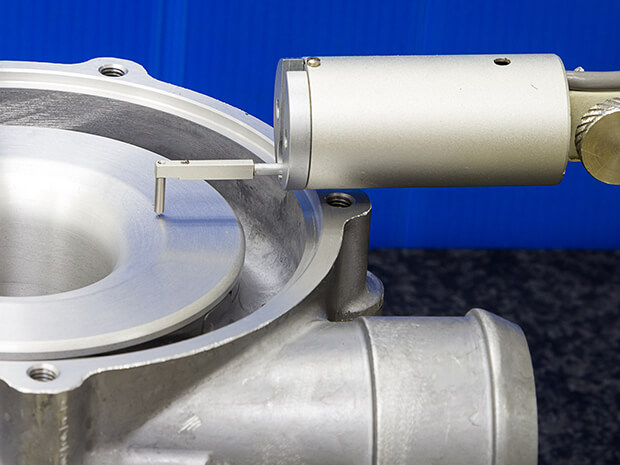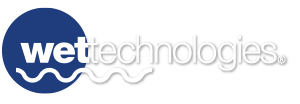Surface finish can be described by three basic characteristics: lay, waviness, and roughness. Lay refers to the directional pattern on the surface, either inherent in the material or produced by the manufacturing process itself. Waviness measures variation in the overall surface. Roughness is the relative difference between microscopic peaks and valleys of a surface profile.
It’s important to manage surface finish, not only for cosmetic reasons, but also to control friction and resistance, ensure accurate fitment, and extend the life of a part or machine. Surface finish is also critical in bonding surfaces together. Proper surface finishing may also prevent or reveal cracks or other imperfections.
Methods for Measuring Surface Finish
Surface finish can be measured in several ways: non-contact, in-process, comparison, or direct measurement methods.
A stylus is used for contact or direct measurements to accurately measure surface finish. This allows the user to create a profile of the roughness parameters. A non-contact method uses lights and optical sensors or ultrasonic pulses instead of a stylus.
Comparison methods involve creating a surface finish sample, using the same technique by which the entire batch of parts is finished. Parts are then compared to this “master” sample which sets the standard for surface finish.
The techniques, which usually include simple tactile or visual verifications, are helpful when the roughness parameters need to be similar in comparison to each other. Of course, these methods aren’t going to be the best option when you need to verify tight tolerances or fine details.
In-process methods will help determine the comparative roughness parameters mid-production process through techniques including magnetic inductance, ultrasound, and machine vision.
If you need specific surface roughness measurements, you can rely on three primary method types:
#1 – Profiling – Provides measurements of the part’s surface using high-resolution scanning probes.
#2 – Area – Measures a region of the surface with optical and ultrasonic scattering techniques, while using statistical models to extrapolate the rest of the part’s surface topology.
#3 – Microscopy – An electron microscopy technique enables the machinist to examine the surface finish to observe fine detail; however, the tools are limited by the small fields of view. Only a small section of the surface can be viewed at one time due to the scale at which electron microscopes operate.
Meanings of Surface Roughness Abbreviations
Some of the commonly used surface roughness symbols and parameters are:
Ra – This is the most commonly used metric when measuring the surface finish. This will tell you the measurement of the average surface roughness of a part. Ra is most utilized in the United States.

Rz – a measure that tells you the average maximum height of a surface profile. The Ra parameter alone can lead to inaccurate measurements at times. Rz assists to reduce errors. Rz measurement is commonly used internationally.
Rmax – This is used to measure the vertical distances of a surface’s valleys and peaks. This is most common for showing scratches, burrs, or other imperfections. Rmax is better for describing anomalies than Ra.
What is Wet Blasting and Why is it Ideal for Surface Finishing?
Wet blasting applies pressurized wet slurry to a surface for finishing effects. Slurry is made from fine abrasive media added to water. This mixture needs to be consistently agitated to reduce any settling of the abrasive.
Wet blasting also acts as an abrasive cleaning method in which water-borne particles blasted at a surface at high velocities assist with eliminating mill scale, rust, old coatings, and contaminants from a substrate.
The blast gun, or nozzle, is key to the Wet Tech method. The abrasive is thoroughly mixed with water at the bottom of the sump. The well-blended slurry leaves the nozzle—or an array of nozzles—at the desired pressure and angle.
Benefits of Wet Blasting
There are four main benefits when using wet blasting on aerospace.
#1 – No static charge – Wet blasting does not build static charge. However, cold sparks are a possibility with certain substrates like Manganese and Titanium.
#2 – Cleaning – With specific types of wet blasting, you are able to strip the surface, while cleaning it at the same time. By having this option, you won’t need a separate rinsing process to remove soluble salt and media fragments.
#3 – Hydrostatic forces – When you use water, there will be more mass at the point of impact, which means that you won’t need as much abrasive.
# 4 – Dust reduction – When you use water, it eliminates the hazard of dust from the abrasive blasting process.
#5 – Control – Water acts as a cushion, making it easy to avoid over-blasting the substrate.
Why is Wet Blasting Better Than Dry Blasting?
Dry blasting can be cost-effective and versatile, but it poses a couple of major safety concerns. Three advantages of wet blasting over dry blasting are:
Eliminate Static Explosion Risk – Hot sparks are created during the dry abrasive blasting process, which can cause a fire or explosion in flammable environments. Wet blasting eliminates this risk.
Eliminate Health Hazards – The abrasive dust that is released from the dry abrasive blasting process can cause harm to the working parties if they inhale the particles. With respiratory protective equipment, this could be managed, but wet blasting is a safer, more convenient option.
Reduce Steps to Prep Parts – If parts are wet and or greasy going into a sandblasting cabinet, the media will clump, the pneumatics get clogged, and sludge can build up in the cabinet, causing a troublesome operation and a major cleanup. Wet blasting eliminates the need to clean or dry parts prior to blasting, saving steps in both prep and cleanup.
Wet Blasting Provides Superior Process Control
One of the major benefits of wet blasting is that it allows the user complete control of the process. This is important with high-precision applications consistent within the aerospace industry. With the advanced technology of wet blasting, users are able to adjust the parameters to create a blasting pressure and slurry flow which can range from delicate all the way to aggressive. Several aerospace applications involve fan blades and turbines that require a controlled peening effect, which can simply be created with wet blasting. The water allows for a cushioning effect that minimizes the risk to parts.
Wet Technologies has a quality assurance program that includes comprehensive training on your new wet technology system. The goal is to make sure you get the best performance out of your system. Our mission over the last two decades has been to focus on the state-of-the-art in every aspect of design, and development. We believe in constantly updating, upgrading, and innovating to provide advanced surface finishing quality.
https://en.wikipedia.org/wiki/Surface_finish
http://tolerancing.net/engineering-drawing/surface-texture.html
https://www.paintsquare.com/psf/?fuseaction=answer&psfID=338
https://www.fastradius.com/resources/measure-surface-finish/
https://www.predev.com/pdffiles/surface_roughness_terminology_and_parameters.pdf









